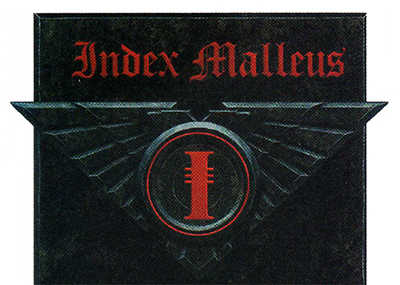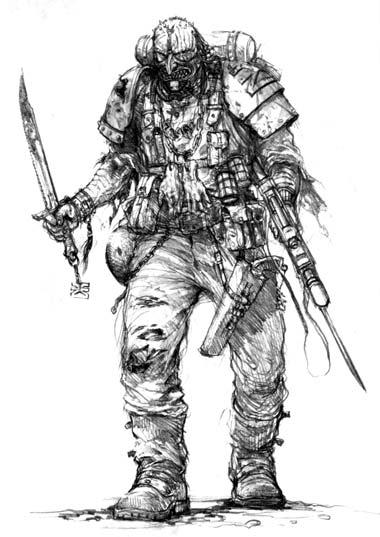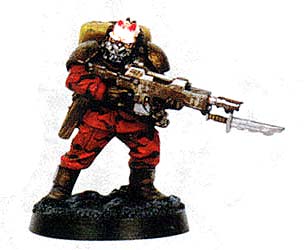 THE BLOOD PACT
An investigation into this notorious threat
to the Imperium by Dan Abnett  From obscure origins as a Chaos cult in the heathen fringes of the Segmentum Pacificus, the Blood Pact has risen to become a notorious threat to the Imperium of Mankind, for they are that rare combination: a fiercely disciplined military order with an unswerving loyalty to the ruinous daemon-gods of the warp. The true and natural likeness of the beings sworn into the vile Blood Pact is rarely seen, for they choose to conceal their faces behind snarling iron face-masks of a crude and ancient pattern. It is certain for the most part that they are humans or human-mutants, though unconfirmed rumours speak of other xenos breed crealures inducted into their ranks.
In general terms, the Blood Pact warriors encountered by Imperial forces usually resemble a ragged or barbaric regiment of the Imperial Guard. They wear fabric battledress uniforms either looted from the corpses of Guardsmen, or manufactured to resemble a basic Imperial design. Over ihis are worn packs, webbing and the usual assortment of infantry kit, including heavy field boots and a steel bowl-helmet. Because their kit, equipment and battle dress is essentially a mix of plunder and homemade, no two Blood Pact troopers are ever identical. Their appearance is rough and ill kempt: their clothing torn, patched and dirty, and helmets chipped and grazed. True to their name, the warriors of the Pact present themselves in blood red. The helmets are painted an arterial crimson, and the uniforms dyed red. It is common knowledge that the blood of enemies is used for this latter purpose as one of the Pact's sorcerous rituals prior to battle. As a result, the Blood Pact warriors exude a revolting, charnel stink, made even less pleasant by the unguents and oils with which they anoint their bodies, and their own parlous standards of hygiene. A Blood Pact warrior's hands always remain bare and ungloved to display the ghastly ritual scars across the palms and knuckles, made at the time of induction to the Pact. In cases where Blood Pact troops have been captured, or when opportunities have arisen to examine their corpses, it has often been found that this ritual scarring covers other parts of the body and face. The ritual iron visors - known as grotesques - worn by the Blood Pact are variations on a single basic design. The Masks portray a howling, screaking, grimacing (some say leering) face, often with a great hooked nose or chin, or both, like a carnival masque. For most ranks, this mask is pitch black, though senior commanders may wear silver or even gold grotesques. Such 'officers' also affect uniform styles equivalent to the Imperial Guard, with epaulets, gold fragging and jackboots, etc. The Blood Pact speak all the languages of corruption and - thanks to their many origin worlds - a haphazard mix of Imperial dialects and sub-dialects. However, Warmaster Macaroth's tactical advisors have determined that the Blood Pact use their own unique 'battle tongue' or combat jargon in the theatre. This, so far, has proved indecipherable.
Myths and hearsay speak of the order arising on an outworld called Ghourra or Gaurra on the edge of the disputed Sabbat Worlds. This would be some three thousand years ago. The dynastic, tribal society of Ghourra was ruled by a feudal overlord, or Gaur (alt 'Ghour' or 'Gour'). The Gaur surrounded himself with an elite warrior priesthood who conducte the ritual observances by which the Gaur made tribute to his daemon-god. Khorne. This priesthood evolved over time into an outright bodyguard which practised its martial skills as strictly and diligently as the priesthood had conducted their bloody rites. As the Gaur's strength grew, and his influence began to spread to neighbouring worlds, it was this bodyguard force that led the conquering armies. Soon it became a mark of respect to be 'bloody parted" to the Gaur. Numbers grew, recruiting from vassal worlds, and the bodyguard became an army in its own right. Thus was the Blood Pact as we know it spawned. Uniquely, every single member of the Blood Pact (and tactical estimates suggest there may be as many as three quarters of a million Blood Pact warriors) is personally inducted into service by the Gaur himself. To prove his allegiance in blood to both the Gaur and the Blood God, each aspirant ritually gashes his hands on the sharpened edges of the Gaur's battle armour. The Blood Pact were first encountered during the Imperial Crusade to liberate the Sabbat Worlds, a chain of nearly one hundred inhabited systems along the edge of the Segmentum Pacificus. An oft-disputed area, the Sabbat Worlds had first been colonised as part of the Imperium in M35, when Chaos was driven from that sector by the original crusade of St Sabbat, a shepherd girl from Hagia, after whom the worlds were named. In the late 600s and early 700s of M41, a vast Chaos host commanded by the abominable warlord, or 'Archon' Nadzybar swept through the Sabbat Worlds and tore them out of Imperial hands. Nadzybar's host - raised in the feral marches beyond Imperial space - was not one single army, but in fact a cooperative alliance of many, each one led by its own demagogue warlord. These warlords became Nadzybar's lieutenants, and the names of many live in infamy: Anakwanar Sek, Enok Innokenti, Shebol Red-Hand, Sholen Skara, Heritor Asphodel, Nokad the Blighted, Qux of the Eyeless and Urfock Gaur. In 755.M41, the High Lords ot Terra charged the great Slaydo with the task of raising a liberating army and retaking the Sabbat Worlds, Slaydo, who had already assembled a considerable force to victoriously prosecute the Khulan Wars, was named Warmaster, and quickly built a formidable Crusade host to take on a major part of Nadzybar's strength at Balhaut. Though Slaydo himself perished in the battle, this was a famous Imperial victory. Archon Nadzybar was slain and his forces put to rout. Under Macaroth. Slaydo's successor as Warmaster, the Imperial Crusade began to drive the Chaos presence from the Sabbat Worlds. But even with Nadzybar dead, this was not an easy task. By 772.M41, after protracted infighting, a new Archon had emerged from the ranks of the warlords to take Nadzybar's place. This was Urlock Gaur. His forces began to counter-attack Macaroth's, thus beginning the third and perhaps most bitter phase of the protracted conflict. Gaur's Blood Pact had been encountered in combat during the early years of the Crusade, but never properly identified. However, once he became Archon, the Blood Pact became a backbone element of the Chaos host. It is believed many other arch-enemy units and divisions, wishing to prove their loyalty to the new Archon, converted to the Blood Pact. The trained and disciplined nature of the Pact also appealed to the many converted, corrupted or traitorous Imperial Guard units captured during Nadzybar's For ten years, this massive Imperial assault force struggled to gain a foothold in the Sabbat Worlds, for the Archon's armies were monstrously powerful. Eventually, Warmaster Slaydo manoeuvred his Crusade force into place occupation of the Sabbat Worlds. Within just a few years, the Crusade forces came to recognise the Blood Pact as elite infantry of the arch-enemy. The Blood Pact is a martial force of distinction, a fact that often takes its enemies by surprise. The forces of Chaos are often feral, ruthless and zealous and - while savage assets in battle - these qualities often mitigate against effective battlefield operations. Unlike, for example, the Kith who followed Sholen Skara, the Blood Pact is not an army of poorly-equipped fanatics who overrun their enemies by sheer berserk fury. The Blood Pact is drilled and trained in warfare techniques to a standard of competence at least equivalent to the Imperial Guard. They have excellent (often captured) communication systems, and an unshakeable chain of command, meaning that they can be confidently deployed with tactical precision. The Blood Pact can hit specific targets or accomplish specific missions, and individual warriors have the intelligence and field training to operate independently, if necessary, for the Pact's interests. This is what makes them so dangerous. They are not mindless fanatics; they are excellent battlefield soldiers in the sworn service of Chaos. Certain elite or veteran sections of the Pact coterie form the so-called 'Death Brigades", representing the finest and most ruthless storm squads in the Blood Pact. Though comparatively few in number, the Death Brigades are often encountered at the spearhead of assaults, as the private company of senior Chaos leaders, or deployed on specialist missions, and are justly the most dreaded of all Blood Pact units. A representative Blood Pact trooper will be armed with a lasgun or autogun as his primary weapon. Troopers may also carry pistols, stick grenades and bayonets. In close-quarter environments such as trenches or when storming techniques are required, they favour plate or chain mail tunics and arm themselves with billhooks, trench clubs and grenades. Some are able combat specialists in the field of demolition or marksmanship. Blood Pact units will contain a mix of heavy and support weapons comparable to the Imperial Guard, including heavy autoguns, flamers, mortars and rocket launchers. Some Imperial theorists claim that the officers of the Blood Pact deliberately style their organisation on the model of the Imperial Guard, and it is certainly the case that traitor Guardsmen are used to hone and improve the basic combat abilities of the Pact. Such traitors -thankfully rare - are distributed throughout the Pact's numbers to disseminate good techniques. Others point out that Blood Pact armaments resemble those of the Imperial Guard because these are the most commonly plundered. Several munition-producing forge worlds -especially Neffethyl and Urdesh - were amongst the planets conquered in the Sabbat cluster, and from them the Blood Pact have enjoyed a ready supply of Guard-quality weapons. The Blood Pact - again thanks to the captured forge worlds and spoils of war - have proficient armour and artillery divisions. Imperial field pieces are often found in their possession. Blood Pact armour is generally slightly inferior to standard Imperial, most of it being Urdeshi-pattern armoured cars such as the STeG 4, and the AT70 Reaver-pattern tanks, though they do also have more limited numbers of the larger and more powerful AT83 Brigand-pattern tanks, as well as captured examples of Leman Russ and Chimera. The Blood Pact also fields Defilers, as well as a lighter-armoured variation known as the Stalk-tank. Stalk-tanks are powered by six arachniform piston limbs, and are armed with double pulse-lasers in mini-turrets. On very rare occasions, the Pact has also been found to have Baneblade super-heavy tanks in its vanguard. All Blood Pact armoured vehicles are painted red, inscribed with numerous obscene Khornate slogans, and are often decorated with the skulls and hides of their enemies. The Blood Pact is a direct and grave military threat to Imperial security in the Segmentum Pacificus. Its disciplined and trained nature means that it represents something of elite branch of the arch-enemy's host. Furthermore, concern must be expressed as to its increasing size. Urlock Gaur is a charismatic leader, and the Blood Pact is an aspirational order for many young warriors. The Blood Pact is also a painful object lesson as to how the primary skills and strengths of the noble Imperial Guard may be turned against the Imperium itself.
Imperial military leaders are urged to suppress Blood Pact activity wherever it is found. The appearance of Blood Pact forces must be communicated at all costs to Fleet or sub-sector command, as it indicates a pre-planned, tactical enemy action as opposed to a random uprising or raid. The vile and heretical legions of Chaos are ordinarily a supreme menace to the Imperium of Man because of their bludgeoning ferocity and near numberless strengths. The Blood Pacs is a rare example of a more precise and deliberate destructive force. Records also show that though the Pact show little quarter, they are more likely to attempt to turn and recruit Imperial soldiers (by force if necessary) than other Chaos forces. A marked trait of the Blood Pact is its willingness to collaborate with xenos breeds and alien mercenaries from the outworlds and marches to achieve military objectives. Most notably, the Blood Pact often operates alongside non-human mercenaries called the Loxatl, using them as shock troops. The Loxatl are sinuous, non-humanoid quadrupeds evolved from amphibian forms. Slighter larger than a human, they are extremely swift and dexterous, and use large dew-claws to give them purchase on any surface, allowing them to run up walls and across ceilings. Out of water, the vision, hearing and smell of these grey- skinned aliens is dull, and they rely on powerful taste and vibration sensing to hunt and corner prey. Loxatl use a weapon of alien assign known as a flechette blaster. They carry these powerful weapons -along with ammunition bandoleers - on their torsos, mounted on mechanical armatures that fire the weapons via some unknown mind impulse device. This leaves a Loxatl's limbs free for climbing. The blasters fire deadly shot-bursts filled with millions of razor-sharp filaments that shred armour and cause grievous wounds in their targets flesh. Loxatl are believed to operate in small, 'brood group' units of biological kin, communicating by vibration, subsonic calls and - when in close proximity -iridescent patterning that they are able to flash and move across their skins. Imperial Guardsmen have reported that nearby Loxatl activity can often be detected by a nauseating smell, a mix of rancid milk and crushed mint. BLOOD PACT DEATH BRIGADES
BY ANDY HOARE
For those who wish to field a force of the Blood Pact, we've provided some rules and advice for using these dreaded warriors in your games of Warhammer 40,000. The bulk of the Blood Pact is best represented using the Lost and the Damned army list found in Codex: Eye of Terror. Traitors can be used to represent the line troopers of the Blood Pact, and Defilers can represent Stalk-tanks. Beyond this, you should try to avoid using Chaos Space Marine allies, Daemons, Mutants etc, but as similar troop types do turn up in Dan Abnett's novels we wouldn't want to go so far as banning them from the list. For the elite Death Brigades, add the following unit entry to your Lost and the Damned army.
Number/squad: 5-10
Weapons: Lasgun and frag grenades. Options: Any model may exchange their lasgun for an autogun, shotgun, or laspistol/autopistol and close combat weapon for free. Up to two models may exchange their weapon for a flamer at +3 points, a meltagun at +10 points, a plasma gun at +10 points or a grenade launcher at +10 points. One model may be equipped with a demolition charge at +10 points. The squad can be equipped with krak grenades at +2 points per model. The squad may be equipped with chain mail and steel plate assault armour, improving their Armour save to 4+ at +3 points per model. Characters: For +10 points, one Death Brigade Trooper may be upgraded to a Veteran squad leader, who may be given 15 points of equipment from the Chaos Space Marine Armoury (but no Marks, Gifts or other items). Veterans: The Death Brigades are made up of dangerous and experienced veterans of many wars against the Imperium. To represent this, each squad may be given a single Veteran Skill chosen from the Chaos Space Marine armoury, paying the points cost listed there. Purchasing a Veteran Skill will move the unit to the Elites section of the army list. |
||||||||||||||||||||||||||||||||||||||||||||||||||
 The
Blood Pact, by their very nature, have no homeworld. They recruit from
the murky feral worlds of the Chaos Marches beyond Imperial territory,
and also from the populations of worlds they conquer and overrun.
The
Blood Pact, by their very nature, have no homeworld. They recruit from
the murky feral worlds of the Chaos Marches beyond Imperial territory,
and also from the populations of worlds they conquer and overrun.